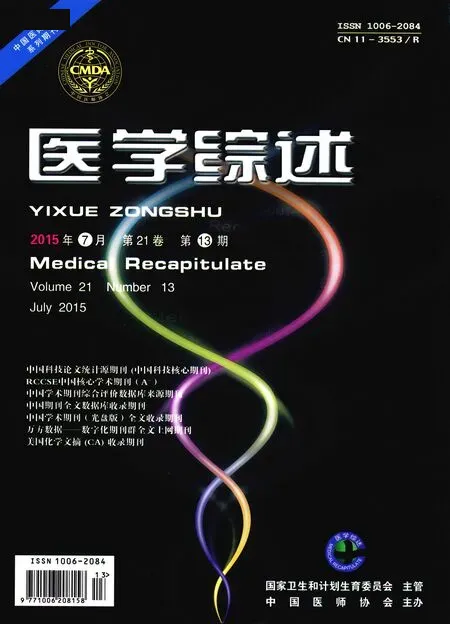Id1和E2-2參與血管內皮損傷修復機制的研究進展
夏 曦(綜述),王 紅(審校)
(成都軍區昆明總醫院干部病房,昆明650032)
?
Id1和E2-2參與血管內皮損傷修復機制的研究進展
夏曦△(綜述),王紅※(審校)
(成都軍區昆明總醫院干部病房,昆明650032)
摘要:血管內皮細胞及內皮祖細胞增殖、遷移是促進血管內皮損傷修復及有益再生,防治動脈粥樣硬化等血管損傷性疾病的重要因素。近年來大量研究證明,分化抑制因子1(Id1)、轉錄因子E2-2在血管內皮細胞及內皮祖細胞增殖、遷移調控過程中起重要作用,共同參與血管內皮損傷修復,但機制尚不完全清楚。深入探討Id1及E2-2對以上功能調控的分子機制將為促進血管內皮有益再生提供重要科學依據。
關鍵詞:血管內皮損傷修復;分化抑制因子1;E2-2;增殖;遷移
Migration
血管內皮損傷及功能障礙是動脈粥樣硬化發生、發展的核心機制,促進損傷內皮修復及有益再生是防治動脈粥樣硬化的關鍵。血管內皮損傷修復的重要環節包括:①損傷部位毗鄰的血管內皮細胞(endothelial cells,ECs)增殖、遷移。②內皮祖細胞(endothelial progenitor cells,EPCs)從骨髓中動員、遷移到內皮損傷部位,并增殖、分化為ECs,促進血管內膜再內皮化;同時通過旁分泌途徑促進ECs的增殖和遷移[1-4]。因此,提高ECs及EPCs增殖、遷移活性,對防治AS具有重要意義。近年來大量研究證明,分化抑制因子1(inhibitors of cell differentiation 1,Id1)、E2-2在 ECs及EPCs增殖、遷移過程中起著重要的作用。現對Id1、E2-2在ECs及EPCs增殖、遷移過程中的調控作用及其機制進行綜述。
1分子生物學概述
Id1是Ids家族成員之一,屬于螺旋-環-螺旋(helix-loop-helix,HLH) 轉錄因子家族,具有保守的HLH結構域,因缺乏與DNA結合的特定堿性氨基酸序列,所以不能直接與DNA結合,且Id1能通過HLH結構域與含有堿性HLH(basic HLH,bHLH) 結構域的蛋白相互結合形成復合物,阻止該蛋白與DNA結合[5]。Id1是HLH轉錄因子負性調控因子,在機體內廣泛存在,參與細胞周期調控,在多種細胞增殖、遷移、凋亡等活性調控方面起重要作用[6-8]。類似調控作用同樣存在于ECs及EPCs增殖、遷移活性調控過程中。
E2-2,HLH轉錄因子家族另一成員,含有bHLH結構域,與轉錄因子E2A、HEB共同組成E蛋白家族,廣泛表達于各組織中。E2-2可以通過自身相互連接形成同源二聚體或者與其他bHLH轉錄因子家族成員形成異源二聚體,二聚體復合物與含有E-box(CANNTG)的DNA序列結合,發揮相應的轉錄調控作用。研究證實,E2-2不僅在調控淋巴系統發育、神經系統分化、肌細胞形成等方面有重要作用[9],還參與ECs及EPCs增殖、遷移活性調控。
2Id1調控ECs及EPCs的增殖與遷移
2.1Id1調控ECs增殖與遷移Id1調控ECs增殖、遷移有多種途徑。研究發現,過表達Id1可通過增強血管內皮生長因子(vascular endothelial growth factor,VEGF)活性,促進ECs增殖、遷移;相反,干擾 Id1的表達可抑制VEGF的轉錄[10]。若加入VEGF的中和抗體抑制VEGF的功能,可阻斷Id1誘導的ECs增殖和管樣形成等能力[11]。Sun等[12]進一步證實Id1經VEGF通路調控ECs增殖,并發現此效應由Id1和一個RNA結合蛋白——Acheron共同參與完成。該實驗室在ECs中過表達Id1,檢測出VEGF、Acheron、整合蛋白β1的表達不同程度增加;敲除Id1,則VEGF、Acheron、整合蛋白β1表達下調。其中,VEGF變化尤為顯著。而過表達Id1同時抑制Acheron表達的ECs與僅過表達Id1的ECs相比,前者VEGF的表達水平顯著下降。此外,該實驗室還發現,正常ECs內Acheron與Id1、整合蛋白β1均有相互結合。血管內皮損傷模型中,該結合現象減弱,誘導整合蛋白β1表達可明顯增強Acheron與Id1結合。由此可以得出,Id1與Acheron、整合蛋白β1共同作用調節ECs中VEGF表達,促進內皮損傷部位毗鄰的ECs增殖,完成血管內皮損傷修復。另一方面,VEGF又能通過細胞外信號調節激酶5信號通路上調ECs中Id1的表達[13],過表達Id1可下調凝血酶敏感蛋白1表達,解除其對VEGF活性的抑制作用,增強ECs增殖、遷移活性,及抗凋亡能力[14]。綜上所述,Id1可上調VEGF表達,促進ECs增殖、遷移,ECs增殖又可增加VEGF表達,進一步促進Id1表達,由此形成一個正反饋環狀通路,增強ECs增殖、遷移活性,促進內皮損傷修復。此外,Id1在ECs中過表達還可明顯抑制抑癌基因p53表達,上調低氧誘導因子1及整合蛋白β1表達,通過低氧誘導因子1/整合蛋白β1依賴性信號通路調控ECs黏附和遷移[15];另一方面,Id1部分抑制p53的核轉位,進一步抑制p53依賴性信號通路活性,促進ECs增殖、遷移,加速損傷內皮再內皮化[16-18]。除以上機制外,另有文獻報道ECs中Id1還可通過抑制轉錄因子E2A與周期蛋白依賴性激酶抑制劑基因p21的啟動子結合,參與p21依賴性細胞周期調控[19]:過表達Id1,抑制p21的轉錄活性,導致p21表達降低;反之,干擾Id1表達,p21轉錄抑制被解除,p21蛋白表達增強。細胞周期分析顯示抑制Id1表達的ECs,處于G1期的細胞比例明顯增多,細胞周期停滯,細胞增殖緩慢;而誘導Id1表達的ECs處于G1期的細胞比例減少,細胞周期演進,細胞增殖加快。由此可得出結論,Id1可通過抑制p21的表達,加快細胞周期演進,促進ECs增殖。Id1通過促進ECs增殖、遷移活性參與內皮損傷修復調控已經得到證實,但其具體的信號通路及下游作用靶點仍需進一步探討。
2.2Id1調控EPCs增殖與遷移外周血中EPCs數量是影響血管損傷修復的重要因素,EPCs動員、增殖、遷移是影響外周血中EPCs數量的重要環節,干擾內源性Id1表達可導致外周血中EPCs數量明顯降低,Id1是調控EPCs活性的關鍵因子[20-22]。近年來,研究證實,在EPCs靜息狀態下,Id1表達低下,而VEGF可增強Id1表達,從而促進EPCs增殖、遷移[23]。進一步研究[24]發現,在EPCs內過表達Id1可上調磷脂酰肌醇3-激酶(phosphatidylinositol 3-kinase,PI3K)、蛋白激酶B(protein kinase B,Akt)、核因子κB (nuclear factor kappa B,NF-κB)、凋亡抑制蛋白(survivin)等的表達,并促進NF-κB/p65核轉位,增強EPCs增殖活性;相反,沉默Id1基因表達,以上蛋白表達顯著降低,NF-κB/p65核轉位明顯減弱,EPCs增殖受到抑制。由以上現象推論Id1可通過PI3K/Akt/ NF-κB/survivin信號通路調控EPCs增殖活性,即:VEGF上調Id1表達,促進上述信號蛋白表達,同時VEGF啟始PI3K激活,通過PI3K/Akt/NF-κB途徑從細胞質中釋放NF-κB進行核轉位,激活其靶基因survivin,促進EPCs增殖。另外,Su等[25]發現,Id1通過PI3K/Akt/NF-κB信號通路同樣能上調基質金屬蛋白酶2表達,調控EPCs參與管樣形成。除以上信號通路外,Id1還可以通過抑制p21表達,促進EPCs在骨髓中生成[26]。Id1調控EPCs參與血管損傷修復過程的重要性已得以證實,同時也顯現出其調控機制的復雜性,因此其分子調控機制尚還需進一步研究。
3E2-2調控ECs及EPCs的增殖與遷移
E2-2普遍表達于機體各組織中,參與調控細胞分化、增殖、維持成熟細胞特性等功能。近年文獻報道,E2-2在ECs增殖、遷移及管樣形成調控過程中也起著重要作用。Tanaka等[27]發現,轉錄因子T-cell acute lymphocytic leukemia 1/stem cell leukemia hematopoietic transcription factor(TAL1/SCL)通過HLH結構域與E2-2結合,抑制E2-2活性,使VEGF受體2(VEGF receptor 2,VEGFR2)基因啟動子活性得以恢復。隨后,進一步研究[28]證實E2-2可通過bHLH結構域,與VEGFR2啟動子中非典型E-box 的DNA序列結合,降低VEGFR2基因的轉錄活性,顯著減少ECs中VEGFR2的表達。因E2-2并未常規的通過VEGFR啟動子中典型E-box起作用,故推測E2-2并非與VEGFR啟動子直接結合,而是參與調控其他轉錄因子與DNA序列結合。另一方面,VEGF信號通路通過VEGFR2受體對ECs增殖、遷移、凋亡等活性產生影響,其下游信號通路之一是有絲分裂原活化蛋白激酶/細胞外調節信號激酶信號通路,當ECs受到VEGF刺激,激活VEGFR2,短時間內細胞外調節信號激酶磷酸化達到高峰,隨后迅速降低[29]。ECs過表達E2-2時,VEGF誘導的細胞外調節信號激酶磷酸化程度明顯削弱[28]。該結果提示,E2-2可降低VEGF/VEGFR2信號通路活性,抑制ECs增殖、遷移;反之,下調E2-2表達,則可解除E2-2對VEGF/VEGFR2信號通路的拮抗作用,促進ECs的增殖、遷移。研究[9,28]還發現,E2-2能抑制基質金屬蛋白酶2及integrin-β4的轉錄,推測E2-2可通過調控其他促血管生成相關因子的轉錄,進一步抑制ECs增殖、遷移。此外,Tanaka等[28]發現,E蛋白家族另一成員E2A同樣能抑制VEGFR2啟動子活性,抑制VEGF/VEGFR2信號通路,最終抑制ECs增殖、遷移。但研究顯示,E2A與轉錄因子TAL-1/SCL 和LIM domain only 2(LMO2)共同作用,上調血管內皮鈣黏素的表達,促進ECs遷移[30]。E蛋白家族調控ECs增殖、遷移等活性是否隨共同作用因子不同而產生不同效應,尚待更多的研究證實。
4Id1與E2-2相互作用
Id1促進EPCs動員進入外周血,維持并參與調控ECs及EPCs增殖、遷移活性;E2-2抑制ECs的增殖、遷移。Id1與E2-2在功能上相互拮抗。已有文獻證實Id蛋白家族實現其負性調控功能的主要途徑是通過阻止機體內廣泛表達的bHLH蛋白(包括E蛋白家族)形成同源二聚體或與組織特異性bHLH蛋白形成異源二聚體,或者阻止該二聚體復合物與DNA結合[31]。在神經系統發育過程中,E2-2與相應的組織特異性bHLH蛋白形成異源二聚體調控細胞分化,過表達Id1能抑制E2-2對該細胞分化的調控[32],可見在正常機體內,存在Id1與E2-2相互作用。近期有研究證明在ECs增殖、遷移調控過程中Id1同樣存在與E2-2相互作用。Tanaka等[28]發現,Id1通過其HLH結構域與E2-2的HLH結構域相結合,解除E2-2介導的VEGFR2基因啟動子活性抑制作用,提高VEGF/VEGFR2信號通路活性,促進ECs增殖、遷移;并且Id1能抑制E2-2同源二聚體的形成及解離已存在的E2-2同源二聚體。但E2-2在調控VEGFR2基因啟動子活性過程中是否以同源二聚體作用尚不清楚。新近研究[33]發現,外源性E2-2在EPCs中過表達,能明顯抑制EPCs生長、增殖,同時可下調Id1的表達,E2-2下調Id1表達可能在抑制EPCs增殖的過程中發揮一定作用。以上研究結果提示,Id1和E2-2之間可能通過一定的信號轉導通路相互影響,調控ECs和EPCs的增殖、遷移。另外,Ghosh等[34]發現,類漿樹突細胞成熟發育過程中,E2-2表達降低可誘導Id2表達增強,Id2表達增強進一步抑制E2-2表達。因此,推測Id1與E2-2間也存在上述相互轉錄-翻譯調控方式,但需相關實驗研究進行證實。
5展望
Id1和E2-2參與調控ECs及EPCs增殖、遷移等功能的重要性已得到證實,為防治動脈粥樣硬化等血管損傷性疾病提供了新的靶點。但是,目前Id1和E2-2在防治血管損傷性疾病方面的作用及分子機制尚不完全清楚,還有很多問題亟待解決,如其是否參與ECs及EPCs旁分泌調控仍無文獻報道。深入探討Id1和E2-2調控血管內皮有益再生的作用機制已成為新的關注點,具有重要研究價值。
參考文獻
[1]張銘,聶紹平,馬長生.動脈粥樣硬化內皮祖細胞介導的損傷修復假說[J].中華心血管病雜志,2007,35(7):672-674.
[2]Ruiter MS,van Golde JM,Schaper NC,etal.Diabetes impairs arteriogenesis in the peripheral circulation:review of molecular mechanisms[J].Clin Sci (Lond),2010,119(6):225-238.
[3]Kirton JP,Xu Q.Endothelial precursors in vascular repair[J].Microvasc Res,2010,79(3):193-199.
[4]Li Calzi S,Neu MB,Shaw LC,etal.EPCs and pathological angiogenesis:when good cells go bad[J].Microvasc Res,2010,79(3):207-216.
[5]Yokota Y,Mori S,Role of Id family proteins in growth control[J].J Cell Physiol,2002,190(1):21-28.
[6]Hui CM,Cheung PY,Ling MT,etal.Id-1 promotes proliferation of p53-deficient esophageal cancer cells[J].Int J Cancer,2006,119(3):508-514.
[7]Cheung HW,Ling MT,Tsao SW,etal.Id1 induced Raf_MEK pathway activation is essential for its protective role against taxol-induced apoptosis in nasopharyngeal carcinoma cells[J].Carcinogenesis,2004,25(6):881-887.
[8]Maw MK,Fujimoto J,Tamaya T.Overexpression of inhibitor of DNA-binding (ID)-1 protein related to angiogenesis in tumor advancement of ovarian cancers[J].BMC Cancer,2009,9:430.
[9]Yang W,Itoh F,Ohya H,etal.Interference of E2-2-mediated effect in endothelial cells by FAM96B through its limited expression of E2-2[J].Cancer Sci,2011,102(10):1808-1814.
[10]Nishiyama K,Takaji K,Kataoka K,etal.Id1 gene transfer confers angiogenic property on fully differentiated endothelial cells and contributes to therapeutic angiogenesis[J].Circulation,2005,112(18):2840-2850.
[11]Ling MT,Lau TC,Zhou C,etal.Overexpression of Id-1 in prostate cancer cells promotes angiogenesis through the activation of vascular endothelial growth factor (VEGF) [J].Carcinogenesis,2005,26(10):1668-1676.
[12]Sun R,Chen W,Zhao X,etal.Acheron regulates vascular endothelial proliferation and angiogenesis together with Id1 during wound healing[J].Cell Biochem Funct,2011,29(8):636-640.
[13]Doebele RC,Schulze-Hoepfner FT,Hong J,etal.A novel interplay between Epac/Rap1 and mitogen-activated protein kinase kinase 5/extracellular signal-regulated kinase 5 (MEK5/ERK5) regulates thrombospondin to control angiogenesis[J].Blood,2009,114(20):4592-4600.
[14]Stapleton CJ,Armstrong DL,Zidovetzki R,etal.Thrombospondin-1 modulates the angiogenic phenotype of human cerebral arteriovenous malformation endothelial cells[J].Neurosurgery,2011,68(5):1342-1353.
[15]Qiu J,Wang G,Zheng Y,etal.Coordination of Id1 and p53 activation by oxidized LDL regulates endothelial cell proliferation and migration[J].Ann Biomed Eng,2011,39(12):2869-2878.
[16]Mettouchi A,Meneguzzi G.Distinct roles of beta1 integrins during angiogenesis[J].Eur J Cell Biol,2006,85(3/4):243-247.
[17]Carlson TR,Hu H,Braren R,etal.Cell-autonomous requirement for beta1 integrin in endothelial cell adhesion,migration and survival during angiogenesis in mice[J].Development,2008,135(12):2193-2202.
[18]Qiu J,Wang G,Hu J,etal.Id1-induced inhibition of p53 facilitates endothelial cell migration and tube formation by regulating the expression of beta1-integrin[J].Mol Cell Biochem,2011,357(1/2):125-133.
[19]孫榮距,閆樂媛,張建波,等.分化抑制因子1促進血管內皮細胞增殖的機制研究[J].解放軍醫學雜志,2010,35(4):364-366.
[20]Lyden D,Hattori K,Dias S,etal.Impaired recruitment of bone-marrow-derived endothelial and hematopoietic precursor cells blocks tumor angiogenesis and growth[J].Nat Med,2001,7(11):1194-1201.
[21]Shaked Y,Ciarrocchi A,Franco M,etal.Therapy-induced acute recruitment of circulating endothelial progenitor cells to tumors[J].Science,2006,313(5794):1785-1787.
[22]Gao D,Nolan DJ,Mellick AS,etal.Endothelial progenitor cells control the angiogenic switch in mouse lung metastasis[J].Science,2008,319(5860):195-198.
[23]Wang H,Yu Y,Guo RW,etal.Inhibitor of DNA binding-1 promotes the migration and proliferation of endothelial progenitor cells in vitro[J].Mol Cell Biochem,2010,335(1/2):19-27.
[24]Li W,Wang H,Kuang CY,etal.An essential role for the Id1/PI3K/Akt/NFkB/survivin signalling pathway in promoting the proliferation of endothelial progenitor cells in vitro[J].Mol Cell Biochem,2012,363(1/2):135-145.
[25]Su Y,Gao L,Teng L,etal.Id1 enhances human ovarian cancer endothelial progenitor cell angiogenesis via PI3K/Akt and NF-kappa B/MMP-2 signaling pathways[J].J Transl Med,2013,11:132.
[26]Ciarrocchi A,Jankovic V,Shaked Y,etal.Id1 Restrains p21 Expression to control endothelial progenitor cell formation[J].PLoS One,2007,2(12):e1338.
[27]Tanaka A,Itoh F,Itoh S,etal.TAL1/SCL relieves the E2-2-mediated repression of VEGFR2 promoter activity[J].J Biochem,2009,145(2):129-135.
[28]Tanaka A,Itoh F,Nishiyama K,etal.Inhibition of endothelial cell activation by bHLH protein E2-2 and its impairment of angiogenesis[J].Blood,2010,115(20):4138-4147.
[29]Olsson AK,Dimberg A,Kreuger J,etal.VEGF receptor signalling:in control of vascular function[J].Nat Rev Mol Cell Biol,2006,7(5):359-371.
[30]Deleuze V,Chalhoub E,El-Hajj R,etal.TAL-1/SCL and its partners E47 and LMO2 up-regulate VE-cadherin expression in endothelial cells[J].Mol Cell Biochem,2007,27(7):2687-2697.
[31]Perk J,Iavarone A,Benezra R.Id family of helix-loop-helix proteins in cancer[J].Nat Rev Cancer,2005,5(8):603-614.
[32]J?gi A,Persson P,Grynfeld A,etal.Modulation of basic helix-loop-helix transcription complex formation by Id proteins during neuronal differentiation[J].J Biol Chem,2002,277(11):9118-9126.
[33]劉曉麗,楊海捷,譚志勝,等.E2-2基因腺病毒載體的構建及其對EPCs生長、增殖及ID1表達的影響[J].第三軍醫大學學報,2014,36(16):1664-1669.
[34]Ghosh HS,Cisse B,Bunin A,etal.Continuous expression of the transcription factor e2-2 maintains the cell fate of mature plasmacytoid dendritic cells[J].Immunity,2010,33(6):905-916.
Research Progress in Mechanisms of Id1 and E2-2 Regulation on Repair of Injured EndotheliumXIAXi,WANGHong.(CadresWard,KunmingGeneralHospitalofChengduMilitaryRegion,Kunming650032,China)
Abstract:The proliferation and migration of vascular endothelial cells and endothelial progenitor cells play an important role in repair of injured endothelium and prevent vascular injury diseases,such as atherosclerosis.Recently,a large amount of studies found the significant effects of inhibitor of cell differentiation-1 (Id1) and transcription factor E2-2 on the proliferation and migration of these cells.However,the mechanisms are not fully understood.Further exploring the mechanisms about how Id1 and E2-2 regulate the functions of endothelial progenitor cells will provide important scientific basis for reendothelialization.
Key words:Repair of injured endothelium; Inhibitor of cell differentiation-1; E2-2; Proliferation;
收稿日期:2014-08-04修回日期:2014-12-02編輯:相丹峰
基金項目:國家自然科學基金(81270224)
doi:10.3969/j.issn.1006-2084.2015.13.002
中圖分類號:R331
文獻標識碼:A
文章編號:1006-2084(2015)13-2308-03

